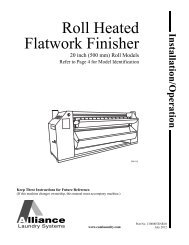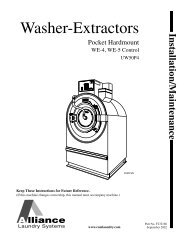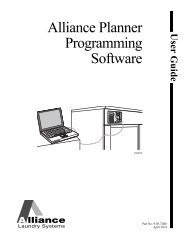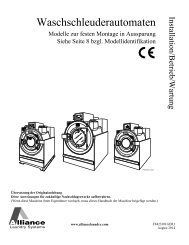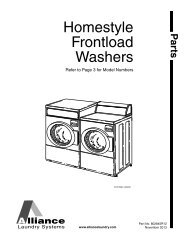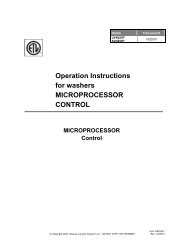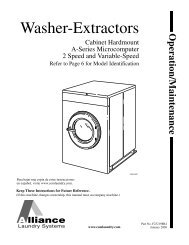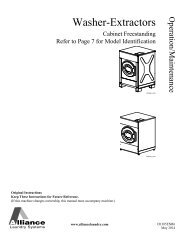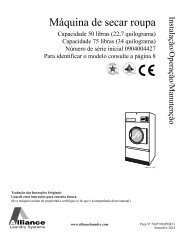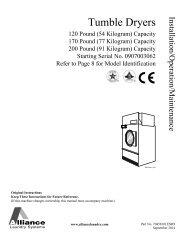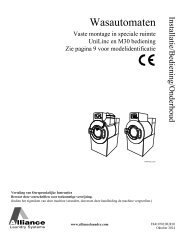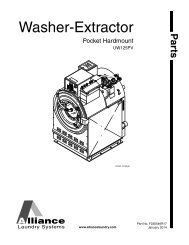Installation Instructions for Frontload Washers - UniMac
Installation Instructions for Frontload Washers - UniMac
Installation Instructions for Frontload Washers - UniMac
Create successful ePaper yourself
Turn your PDF publications into a flip-book with our unique Google optimized e-Paper software.
<strong>Installation</strong> <strong>Instructions</strong><br />
<strong>for</strong> <strong>Frontload</strong> <strong>Washers</strong><br />
Inside.....................................<br />
Washer Dimensions........................................................... 2<br />
Be<strong>for</strong>e You Start................................................................ 2<br />
<strong>Installation</strong>......................................................................... 3<br />
Installer Checklist.............................................................. Back Cover<br />
Date Purchased ________________<br />
Model Number ________________<br />
Serial Number _________________<br />
Para bajar una copia de estas instrucciones en español, visite www.comlaundry.com.<br />
Keep these instructions <strong>for</strong> future reference.<br />
(If this machine changes ownership, this manual must accompany machine.)<br />
www.comlaundry.com<br />
Part No. 802749R2<br />
April 2012
Washer Dimensions<br />
24 in.<br />
(61 cm)<br />
13.1 in.<br />
(33.3 cm)<br />
41.375 in. (105.1 cm)<br />
31.1 in. (79 cm)<br />
29.6 in. (75.1 cm)<br />
37.44 in. (95.1 cm)<br />
14.6 in.<br />
(37.1 cm)<br />
1.5 in.<br />
(3.8 cm)<br />
28 in. (71.1 cm)<br />
2 in. (5.1 cm)<br />
26.875 in. (68.3 cm)<br />
FLW2205N<br />
FLW2205N<br />
Figure 1<br />
Be<strong>for</strong>e You Start<br />
Supplies<br />
For most installations, the basic supplies you will need<br />
are:<br />
3<br />
4<br />
1<br />
1 Safety Glasses<br />
2 Wood Block<br />
3 Wrench<br />
4 Screwdriver<br />
5 Pliers<br />
6 Socket Wrench<br />
7 Level<br />
5<br />
9/16"<br />
2<br />
7<br />
6<br />
FLW2045N<br />
Parts Included<br />
An accessories bag has been shipped inside your<br />
washer. It includes:<br />
• Two fill hoses with washers and filter screens.<br />
Refer to step 2 of <strong>Installation</strong>.<br />
• Four rubber feet. Refer to step 4 of <strong>Installation</strong>.<br />
• Beaded strap. Refer to step 3 of <strong>Installation</strong>.<br />
• Literature CD.<br />
• Literature Guides.<br />
NOTE: If the washer is delivered on a cold day<br />
(below freezing), or is stored in an unheated room<br />
or area during the cold months, do not attempt to<br />
operate it until the washer has had a chance to<br />
warm up.<br />
NOTE: Some moisture in the wash drum is normal.<br />
Water is used during testing at the manufacturer.<br />
NOTE: Install dryer be<strong>for</strong>e washer. This allows<br />
room <strong>for</strong> attaching exhaust duct.<br />
Figure 2<br />
2<br />
© Copyright, Alliance Laundry Systems LLC – DO NOT COPY or TRANSMIT 802749
<strong>Installation</strong><br />
Step 1: Position Washer Near <strong>Installation</strong><br />
Area<br />
Move washer as close to the desired area of<br />
installation as possible.<br />
NOTE: For best per<strong>for</strong>mance and to minimize<br />
vibration or movement, install washer on a solid,<br />
sturdy and level floor. Some floors may need to be<br />
rein<strong>for</strong>ced, especially on a second floor or over a<br />
basement. Do not install the washer on carpeting,<br />
soft tile, a plat<strong>for</strong>m or other weakly supported<br />
structures.<br />
Step 2: Position and Level the Washer<br />
Make sure that the washer does not rock. When<br />
washer is level and does not rock, tighten locknuts<br />
securely against bottom of washer base. If these<br />
locknuts are not tight, washer will move out of<br />
position during operation.<br />
Do not slide washer across floor once the leveling legs<br />
have been extended. Legs and base could become<br />
damaged.<br />
Place rubber feet (supplied in accessories bag) on all<br />
four leveling legs. Refer to Figure 3.<br />
Verify that washer does not rock.<br />
6<br />
1<br />
WARNING<br />
<strong>Washers</strong> elevated above floor level must<br />
be anchored to that elevated surface,<br />
base or plat<strong>for</strong>m. The material used to<br />
elevate the washer should also be<br />
anchored to the floor to ensure that the<br />
washer will not walk or that the washer<br />
can not be physically pulled, tipped or<br />
slid from its installed position. Failure to<br />
do so may result in conditions which can<br />
produce serious injury, death and/or<br />
property damage.<br />
W306<br />
Position washer so it has sufficient clearance <strong>for</strong><br />
installation and servicing.<br />
NOTE: Use of the dispenser drawer or washer door<br />
as a handle in the transportation of the washer may<br />
cause damage to the dispenser or door.<br />
4<br />
5<br />
3<br />
2<br />
1 Level<br />
2 Wood Block<br />
3 Rubber Foot<br />
4 Leveling Leg<br />
5 Locknut<br />
6 Washer Base<br />
Figure 3<br />
FLW229<br />
FLW2290N<br />
Place washer in position on a solid, sturdy and level<br />
floor. Installing the washer on any type of carpeting,<br />
soft tile, a plat<strong>for</strong>m or other weakly supported<br />
structures is not recommended.<br />
For easier access to leveling legs, prop up washer with<br />
a wooden block. Refer to Figure 3.<br />
Place a level on the cabinet top and check if the<br />
washer is level from side to side and front to back.<br />
NOTE: Level must rest on raised portion of top<br />
panel. Refer to Figure 3.<br />
If washer is not level, tilt washer to access the front<br />
and rear leveling legs. Loosen the locknuts and adjust<br />
legs by screwing into or out of washer base.<br />
802749<br />
© Copyright, Alliance Laundry Systems LLC – DO NOT COPY or TRANSMIT 3
Step 3: Connect Fill Hoses<br />
Water Supply<br />
Water supply faucets must fit standard 3/4 inch<br />
(19.1 mm) female garden hose couplings. DO NOT<br />
USE SLIP-ON OR CLAMP-ON CONNECTIONS.<br />
Water supply faucets should be readily accessible to<br />
permit turning them off when washer is not being<br />
used.<br />
Recommended cold water temperature is 60 o to 80 o<br />
Fahrenheit (16 o to 27 o Celsius). Recommended<br />
maximum hot water temperature is 125° Fahrenheit<br />
(51° Celsius). Warm water is a mixture of hot and cold<br />
water. Warm water temperature is dependent upon<br />
water temperature and pressure of both the hot and<br />
cold water supply lines.<br />
Pressure<br />
(psi)<br />
WARNING<br />
Under certain conditions, hydrogen gas<br />
may be produced in a hot water system<br />
that has not been used <strong>for</strong> two weeks or<br />
more. HYDROGEN GAS IS EXPLOSIVE. If<br />
the hot water system has not been used<br />
<strong>for</strong> such a period and be<strong>for</strong>e using the<br />
washer, turn on all hot water faucets and<br />
let the water flow from each <strong>for</strong> several<br />
minutes. This will release any<br />
accumulated hydrogen gas. The gas is<br />
flammable. Do not smoke or use an open<br />
flame during this time.<br />
W029<br />
WARNING<br />
To prevent personal injury, avoid contact<br />
with inlet water temperatures higher than<br />
125° Fahrenheit (51° Celsius) and hot<br />
surfaces.<br />
W748<br />
Mixing Valve Flow Rates<br />
HOT<br />
liters per minute<br />
(gallons per<br />
minute)<br />
COLD<br />
liters per minute<br />
(gallons per<br />
minute)<br />
20 6 (1.6) 9.4 (2.5)<br />
Water pressure must be a minimum of 20 to a<br />
maximum of 120 pounds per square inch (138 to<br />
827 kPa) static pressure measured at the faucet.<br />
NOTE: Water pressure under 20 pounds per<br />
square inch (138 kPa) will cause an extended fill<br />
time in the washer and may not properly flush out<br />
the detergent dispenser.<br />
Turn on the water faucets and flush the lines <strong>for</strong><br />
approximately two minutes to remove any <strong>for</strong>eign<br />
material that could clog the screens in the water<br />
mixing valve.<br />
NOTE: When installing in newly constructed or<br />
renovated buildings, it is very important to flush<br />
the lines since build-up may have occurred during<br />
construction.<br />
Connecting Hoses<br />
Remove the two plain rubber washers and two filter<br />
screens from the accessories bag. Install them into<br />
each end of the fill hoses as shown in Figure 4. The<br />
screen must be facing outward.<br />
Screw hose couplings with the filter screens onto the<br />
water faucets until they are finger-tight. Then, using a<br />
pliers, screw approximately 1/4 turn.<br />
Screw hose couplings from other end of hoses onto the<br />
water mixing valve until they are finger-tight. Then,<br />
using a pliers, screw approximately 1/4 turn. Refer to<br />
Figure 5.<br />
IMPORTANT: Do not cross thread or overtighten<br />
couplings. This will cause them to leak.<br />
Turn water on and check <strong>for</strong> leaks. If leaks are found,<br />
turn off the water, unscrew hoses and reinstall them<br />
until there are no leaks.<br />
IMPORTANT: Turn off water supply whenever<br />
there will be an extended period of non-use.<br />
NOTE: Longer fill hoses are available (as optional<br />
equipment at extra cost) if the hoses supplied with<br />
the washer are not long enough <strong>for</strong> the installation.<br />
Order hoses as follows:<br />
No. 20617 Fill Hose 8 feet (2.44 m)<br />
No. 20618 Fill Hose 10 feet (3.05 m)<br />
40 8.2 (2.2) 13 (3.4)<br />
60 9.9 (2.6) 14.5 (3.8)<br />
100 9.6 (2.5) 15.9 (4.2)<br />
120 9.8 (2.6) 15.9 (4.2)<br />
4<br />
© Copyright, Alliance Laundry Systems LLC – DO NOT COPY or TRANSMIT 802749
5<br />
HOT<br />
COLD<br />
1 Water Faucet<br />
2 Fill Hose<br />
3 Plain Rubber Washer<br />
4 Hose Coupling<br />
5 Filter Screens<br />
1<br />
Figure 4<br />
TLW1976N<br />
IMPORTANT: Hoses and other natural rubber<br />
parts deteriorate after extended use. Hoses may<br />
develop cracks, blisters or material wear from the<br />
temperature and constant high pressure they are<br />
subject to.<br />
All hoses should be checked on a monthly basis <strong>for</strong><br />
any visible signs of deterioration. Any hose showing<br />
the signs of deterioration listed above should be<br />
replaced immediately. All hoses should be replaced<br />
every five years.<br />
2<br />
3<br />
4<br />
Step 4: Connect Drain Hose to Drain<br />
Receptacle<br />
Remove the drain hose from its shipping position on<br />
the rear of the washer by unhooking the hose from the<br />
retainer clamp and by removing the shipping tape.<br />
Install the drain hose into the drain receptacle<br />
(standpipe, wall or laundry tub) following the<br />
instructions below.<br />
IMPORTANT: Drain receptacle must be capable of<br />
handling a minimum of 1-1/4 inch (3.2 cm) outside<br />
diameter drain hose.<br />
Standpipe <strong>Installation</strong>:<br />
Drain Flow Rate<br />
Flow Rate<br />
Drain Height<br />
liters per minute<br />
(gallons per minute)<br />
0.9 m (3 ft.) 31 (8.19)<br />
1.5 m (5 ft.) 27.5 (7.27)<br />
1.8 m (6 ft.) 23.9 (6.31)<br />
2.1 m (7 ft.) 18.5 (4.89)<br />
2.4 m (8 ft.) 10.6 (2.79)<br />
Place the drain hose into the standpipe.<br />
Remove the beaded strap from accessories bag and<br />
place around standpipe and drain hose and tighten<br />
strap to hold hose to standpipe. Refer to Figure 6. This<br />
will prevent the drain hose from dislodging from drain<br />
receptacle during use.<br />
1<br />
2<br />
1<br />
4<br />
1 Water Faucets<br />
2 Cold Water Connection<br />
3 Hot Water Connection<br />
4 Fill Hoses<br />
Figure 5<br />
3<br />
FLW1973N<br />
FLW1973N<br />
2<br />
3<br />
FLW1959N<br />
1 24 in. to 36 in. (91.44 cm recommended<br />
height)<br />
2 Standpipe - 2 in. (5.08 cm) or 1-1/2 in. (4 cm)<br />
3 Beaded Strap<br />
Figure 6<br />
FLW1959N<br />
802749<br />
© Copyright, Alliance Laundry Systems LLC – DO NOT COPY or TRANSMIT 5
Wall <strong>Installation</strong>:<br />
For installations of this type, the drain hose MUST be<br />
secured to one of the fill hoses using the beaded strap<br />
from accessories bag. Refer to Figure 7.<br />
NOTE: End of drain hose must not be below 24 in.<br />
(61 cm).<br />
Laundry Tub <strong>Installation</strong>:<br />
For this type of installation, the drain hose MUST be<br />
secured to the stationary tub to prevent hose from<br />
dislodging during use. Refer to Figure 8. Use the<br />
beaded strap (supplied in accessories bag) to secure<br />
hose.<br />
1<br />
1<br />
2<br />
2<br />
3<br />
1 Drain Hose<br />
2 Beaded Strap (tape if necessary)<br />
3 Fill Hoses<br />
H023I<br />
1 Drain Hose<br />
2 Beaded Strap (tape if necessary)<br />
Figure 8<br />
FLW<br />
FLW1961N<br />
Figure 7<br />
6<br />
© Copyright, Alliance Laundry Systems LLC – DO NOT COPY or TRANSMIT 802749
Step 5: Remove the Shock Sleeves and<br />
Shipping Brace<br />
1. Remove panel.<br />
4. Replace panel.<br />
FLW2272N<br />
FLW2272N<br />
FLW2269N<br />
FLW2269N<br />
Figure 12<br />
Figure 9<br />
2. Remove brace. Five bolts secure brace to<br />
machine. For easier removal, remove in order<br />
shown.<br />
5<br />
1<br />
Figure 13<br />
FLW2268N<br />
FLW2268N<br />
4<br />
3<br />
Figure 10<br />
3. Remove shock sleeves.<br />
2<br />
FLW2270N<br />
IMPORTANT: The shipping brace, bolts,<br />
lockwashers and shock sleeves should be saved and<br />
MUST be reinstalled whenever the unit is moved<br />
more than four feet. Do not lift or transport unit<br />
from front or without shipping materials installed.<br />
Refer to the User’s Guide <strong>for</strong> proper instructions<br />
on reinstalling the shipping materials.<br />
IMPORTANT: DO NOT tip washer more than<br />
6 inches (152.4 mm) in any direction after shipping<br />
brace has been removed. Shock absorbers may<br />
separate and damage to washer may result. For<br />
leveling purposes, the washer may be tilted a<br />
maximum of 6 inches (152.4 mm) in any direction.<br />
Figure 11<br />
FLW2271N<br />
FLW2271N<br />
802749<br />
© Copyright, Alliance Laundry Systems LLC – DO NOT COPY or TRANSMIT 7
Step 6: Wipe Out Inside of Washer Drum<br />
Be<strong>for</strong>e using the washer <strong>for</strong> the first time, use an allpurpose<br />
cleaner, or a detergent and water solution, and<br />
a damp cloth to remove shipping dust from inside the<br />
drum.<br />
Step 7: (Supply Injection Models Only)<br />
Connect External Supplies to Washer<br />
IMPORTANT: Undiluted chemical dripping can<br />
damage the washer.<br />
1. Remove two nozzles from accessories bag. Use<br />
either the 3/8 inch or 1/4 inch nozzles, depending<br />
on the diameter of the dispenser tubing used.<br />
2. Attach nozzles to rear of machine. Connection<br />
point located on cabinet, above water mixing<br />
valve. Refer to Figure 15.<br />
3. Connect supply hoses to nozzles and secure with<br />
hose clamps (obtain locally). Refer to Figure 15.<br />
Figure 14<br />
FLW2155N<br />
NOTE: Hoses can be connected to either nozzle.<br />
4. Refer to supply injection system instructions and<br />
label inside washer junction box cover<br />
(Figure 16) <strong>for</strong> electrical connection.<br />
Do not attempt to make supply injection<br />
electrical connections to points other than those<br />
provided specifically <strong>for</strong> that purpose by the<br />
factory.<br />
5. Refer to supply injection system instructions <strong>for</strong><br />
details on operation.<br />
Supply Injection System<br />
Number of liquid supply connections<br />
(1–Detergent and 2–Softener)<br />
Liquid supply connection size,<br />
in. (mm)<br />
2<br />
3/8 (9.52)<br />
or<br />
1/4 (6.35)<br />
WARNING<br />
Wear eye and hand protection when<br />
handling chemicals; always avoid direct<br />
contact with raw chemicals. Read the<br />
manufacturer’s directions <strong>for</strong> accidental<br />
contact be<strong>for</strong>e handling chemicals. Ensure<br />
an eye-rinse facility and an emergency<br />
shower are within easy reach. Check at<br />
regular intervals <strong>for</strong> chemical leaks.<br />
SW016<br />
8<br />
© Copyright, Alliance Laundry Systems LLC – DO NOT COPY or TRANSMIT 802749
1<br />
1 Injection Point<br />
2 Nozzle<br />
3 Supply Dispenser Pump Outlet<br />
Figure 15<br />
2<br />
3<br />
FLW2162N<br />
These terminals may be used to provide signals to the<br />
supply injection system but must not be used to<br />
provide power to the actual pump.<br />
Any injection system pump which requires<br />
110 VAC must be powered by a separate external<br />
power source.<br />
Control Function Test<br />
The washer should be cleaned after the installation is<br />
complete. A function test should then be executed on<br />
the unloaded machine:<br />
1. Check the power supply <strong>for</strong> such characteristics<br />
as correct voltage, phase, and cycles to be certain<br />
they are correct <strong>for</strong> the washer.<br />
2. Open manual shut-off valves to the washer.<br />
3. Apply power to the washer.<br />
Step 8: Plug in the Washer<br />
Washer requires 120 Volt, 60 Hertz electrical supply<br />
and comes equipped with a 3-prong grounding plug.<br />
Refer to serial plate <strong>for</strong> specific electrical<br />
requirements.<br />
A junction box on the rear panel houses a terminal<br />
strip which furnishes supply output signals <strong>for</strong> the<br />
supply injection pumps. These are dry contacts.<br />
Voltage needs to be supplied. Refer to Figure 16 <strong>for</strong><br />
the injection interface label.<br />
120±12<br />
V.A.C.<br />
1<br />
2<br />
3<br />
0 V.A.C.<br />
CHEMICAL INJECTION<br />
ELECTRICAL INTERFACE<br />
SOFTENER<br />
DISPENSER<br />
CONNECTION<br />
DETERGENT<br />
DISPENSER<br />
CONNECTION<br />
NO CONNECTION<br />
TERMINAL<br />
BLOCK<br />
YELLOW<br />
Figure 16<br />
YELLOW/BLACK<br />
RED<br />
RED/BLACK<br />
SOFTENER<br />
RELAY<br />
DETERGENT<br />
RELAY<br />
NOTE: Normally Open Contacts.<br />
Contacts Close to Start Chemical Injection.<br />
Maximum Load Connection per Contact:<br />
1A @ 120VAC/240VAC<br />
801653R1<br />
FLW2028N<br />
120±12<br />
V.A.C.<br />
Standard 120 Volt, 60 Hertz<br />
3-Wire Effectively<br />
Grounded Circuit<br />
1 L1<br />
2 Ground<br />
3 Neutral Side<br />
4 Round Grounding Prong<br />
5 Neutral<br />
Figure 17<br />
4 5<br />
DRY2022N<br />
802749<br />
© Copyright, Alliance Laundry Systems LLC – DO NOT COPY or TRANSMIT 9
When plugging in the washer:<br />
• DO NOT overload circuits.<br />
• DO NOT use an extension cord.<br />
• DO NOT use an adapter.<br />
• DO NOT operate both a washer and gas dryer on<br />
the same circuit. Use separately fused 15 Amp<br />
circuits.<br />
The washer is designed to be operated on a separate<br />
branch, polarized, three-wire, effectively grounded,<br />
120 Volt, 60 Hertz, AC (alternating current) circuit<br />
protected by a 15 Amp fuse, equivalent fusetron or<br />
circuit breaker.<br />
The three-prong grounding plug on the power cord<br />
should be plugged directly into a polarized three-slot<br />
effectively grounded receptacle rated 110/120 Volts<br />
AC (alternating current) 15 Amps. Refer to Figure 17<br />
to determine correct polarity of the wall receptacle.<br />
Grounding In<strong>for</strong>mation<br />
WARNING<br />
To reduce the risk of fire, electric shock or<br />
personal injury, all wiring and grounding<br />
MUST con<strong>for</strong>m with the latest edition of<br />
the National Electrical Code, ANSI/NFPA<br />
70, and such local regulations as might<br />
apply. It is the customer’s responsibility<br />
to have the wiring, fuses and circuit<br />
breakers installed by a qualified<br />
electrician to make sure adequate<br />
electrical power is available to the<br />
washer.<br />
WARNING<br />
W518<br />
To reduce the risk of an electric shock or<br />
fire, DO NOT use an extension cord or an<br />
adapter to connect the washer to the<br />
electric power source.<br />
W082<br />
The washer must be grounded. In the event of<br />
malfunction or breakdown, grounding will reduce the<br />
risk of electric shock by providing a path of least<br />
resistance <strong>for</strong> electric current.<br />
The washer is equipped with a cord having an<br />
equipment-grounding conductor and a 3-prong<br />
grounding plug. The plug must be plugged into an<br />
appropriate outlet that is properly installed and<br />
grounded in accordance with all local codes and<br />
ordinances.<br />
WARNING<br />
Improper connection of the equipmentgrounding<br />
conductor can result in a risk<br />
of electric shock. Check with a qualified<br />
electrician or service person if you are in<br />
doubt as to whether the washer is<br />
properly grounded.<br />
W216<br />
Do not modify the plug provided with the washer – if<br />
it will not fit the outlet, have a proper outlet installed<br />
by a qualified electrician.<br />
NOTE: Have a qualified electrician check the<br />
polarity of the wall receptacle. If a voltage reading<br />
is measured other than that in Figure 17, the<br />
qualified electrician should correct the problem.<br />
WARNING<br />
This unit is equipped with a three-prong<br />
(grounding) plug <strong>for</strong> your protection<br />
against shock hazard and should be<br />
plugged directly into a properly grounded<br />
three-prong receptacle. Do not cut or<br />
remove the grounding prong from this<br />
plug.<br />
W213<br />
NOTE: The wiring diagram is located behind the<br />
control panel, inside the control cabinet.<br />
Step 9: Check <strong>Installation</strong><br />
Refer to Installer Checklist on the back cover of this<br />
manual and make sure that washer is installed<br />
correctly.<br />
Run washer with a test load to make sure it is<br />
operating properly and properly leveled.<br />
a. Put about six pounds of laundry (four bath<br />
towels and three jeans) into washer.<br />
b. Close door.<br />
c. Select a Spin Only cycle and press Start.<br />
d. When washer spins at high speed, verify that<br />
it is stable.<br />
e. If it is not, after cycle is complete, refer to<br />
Step 2 and readjust leveling legs.<br />
10<br />
© Copyright, Alliance Laundry Systems LLC – DO NOT COPY or TRANSMIT 802749
Installer Checklist<br />
Fast Track <strong>for</strong> Installing the Washer<br />
(Refer to the manual <strong>for</strong> more detailed in<strong>for</strong>mation)<br />
1<br />
• Position Washer Near<br />
<strong>Installation</strong> Area.<br />
5<br />
• Remove the Shock Sleeves<br />
and Shipping Brace.<br />
CHECK<br />
CHECK<br />
FLW2124N<br />
FLW2124N<br />
2<br />
• Position and<br />
Level the Washer.<br />
6<br />
• Wipe Out Inside of<br />
Washer Drum<br />
CHECK<br />
FLW2154N<br />
CHECK<br />
FLW2155N<br />
3<br />
• Connect Fill<br />
Hoses.<br />
HOT<br />
COLD<br />
Filter<br />
Screens<br />
Cold Valve<br />
Connection<br />
7<br />
(Supply Injection Models Only)<br />
• Connect External<br />
Supplies to<br />
Washer<br />
CHECK<br />
Plain <strong>Washers</strong><br />
FLW2054N<br />
Hot Valve Connection<br />
FLW2054N<br />
CHECK<br />
FLW2162N<br />
4<br />
• Connect Drain<br />
Hose to Drain<br />
Receptacle.<br />
8<br />
• Plug in the Washer.<br />
CHECK<br />
FLW1959N<br />
CHECK<br />
D254I D254I<br />
© Copyright, Alliance Laundry Systems LLC – DO NOT COPY or TRANSMIT



